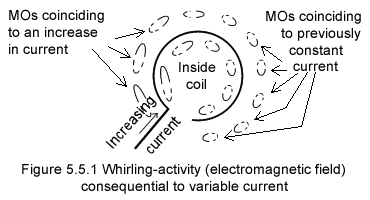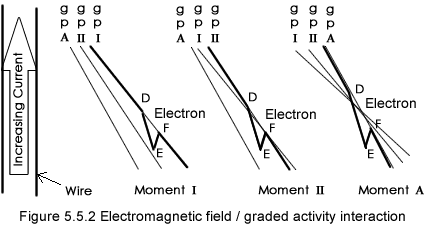Electromagnetic field and photons, whirling-activity (§5.5)
Now we are considering the third and last situation that of varying currents and coinciding to movements I through A of figure 5.3.1, which happens to represent an increase of current in the wire, and which creates the wave shown in the middle of figure 5.3.2. Experiments show that increases of current in a wire or coil set an outside electron in a circling motion around the wire (rather than keeping it still as in §5.3). The electron makes circles and spirals in a plane, which is perpendicular to physics defined field lines of figure 5.2.3; and that happens to be planes paralleling the wire of the coil. Now the electrons find themselves in an a situation as represented in figure 5.5.1.
Experiments show that increases of current in a wire or coil set an outside electron in a circling motion around the wire (rather than keeping it still as in §5.3). The electron makes circles and spirals in a plane, which is perpendicular to physics defined field lines of figure 5.2.3; and that happens to be planes paralleling the wire of the coil. Now the electrons find themselves in an a situation as represented in figure 5.5.1.The pure-activity surrounding the coil, which is oriented along concentric circles, instead of being even (as in figure §5.4.1) is varying; it is either increasing as shown on the figure or decreasing.
The situation changed drastically, the pure-activity individual MOs inclinations and thrusts vary along the circular patterns surrounding the coil, which is different from the variation perpendicular only to these circular patterns that occurs in a magnetic field (figure §5.4.1). The situation is now reminiscent of the radial activity case, in which the radial inclination has been replaced by a whirling one. And a particle over all motion occurrence will be changed in gravimotion along the constantly changing whirling of the subjacent pure-activity; the particle will be carried away and will circle around.
Should the polarity of the current within the coil be reversed, the pure activity's whirling will change direction, and electrical particles in the vicinity of the coil will move in the other direction, just as underwater algeas fluctuate along water waves.
And should these reversal be repeatedly occurring, the pure activity whirling becomes electromagnetic waves, spreading away in all directions, and engendering alternating current of electrons in a remote antena.
 There is another phenomenon that comes into play, which is the wave shown in figure 5.3.2 within pure-activity and which coincides to an increase of graded activity.
There is another phenomenon that comes into play, which is the wave shown in figure 5.3.2 within pure-activity and which coincides to an increase of graded activity.Note that in the situation §5.3 figure 5.3.3 we concluded there were no slanting of pure activity; or that the acclivity due to the current was metamorphosed into oriented-activity. That occurs in this new situation too, in which the current is varying rather than constant, but there is in addition a varying acclivity (or declivity) along the circular patterns paralell to the coil loops. And this is the subject of this paragraph and Figure 5.5.2 describes the situation; note that the figure does no longer involve orientation but density of pure-activity, which also describes transient modifications.
The graded activity is labeled with the 2 letters "g" "p" for "graded-pure-activity", letters that are positioned vertically; and followed also vertically by the 3 movements I, II and A introduced in §5.3.
At movement I the inclination gp I is represented with a bold line, while inclinations gp II and gpA (which are on their way and will arrive next) are represented with faint lines.
Then for each movement the actual situation is in bold while the other are reproduced in faint line. The whole dynamism is similar to that of figure 5.1.1 and its electron also labeled DEF, yet now instead of observing a still graded-activity (which threw the electron out of balance in §5.1), an increasing of the acclivity is in effect, which intensifies the motion of the electron toward the wire; a similar increase of field would work against the motion of a proton.
And different scenarios occur considering various increase/decrease of acclivity/declivity for either electron or proton!
Note that depending on the increase/decrease swiftness of the current in the wire, the electron might describe a circle, a departing spiral or closing spiral. Its trajectory will also depend on the strength of the electromagnetic field; for instance inside the coil it will be frantic.
Due to both phenomenon of whirling figure 5.5.1 and graded activity variation figure 5.5.2, the electromagnetic field called whirling-activity is altogether a variation of "density" and "direction" in essence similar to the combination of electrical and gravitational fields. By contrast the electric field is of gradient type only, and the gravitational field is of directional type only.
It would be interesting to compare the whirling constitution of space surrounding a magnet to the orientation of space surrounding a fly wheel or a gyroscope. Both magnet and gyro have very strong and specific effects that appear to be foreign to each other. A magnet doesn’t display any (noticeable) gyroscopic effect when not spinning, while a gyroscope doesn’t display any (noticeable) magnetic effect.
Gravimotion’s whirling-activity elegantly fills-in for physics' missing mechanism concerning the translation of photons; gravimotion whirling-activity furthermore reunifies in the physical world, physics mathematical duality of light that could have been unified mathematically to start with (§3.4). In gravimotion electromagnetic waves throw electrons into an oscillating motion, a motion growing in thrust with every cycle, and which ends up, for electrons within a photoelectric material, overcoming the surface barrier of the later. A phenomenon that is at the origin of the photon.